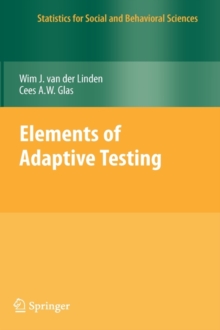
Test Equating, Scaling, and Linking : Methods and Practices PDF
by Michael J. Kolen, Robert L. Brennan
Part of the Statistics for Social and Behavioral Sciences series
Description
This book provides an introduction to test equating, scaling and linking, including those concepts and practical issues that are critical for developers and all other testing professionals. In addition to statistical procedures, successful equating, scaling and linking involves many aspects of testing, including procedures to develop tests, to administer and score tests and to interpret scores earned on tests. Test equating methods are used with many standardized tests in education and psychology to ensure that scores from multiple test forms can be used interchangeably. Test scaling is the process of developing score scales that are used when scores on standardized tests are reported. In test linking, scores from two or more tests are related to one another. Linking has received much recent attention, due largely to investigations of linking similarly named tests from different test publishers or tests constructed for different purposes. In recent years, researchers from the education, psychology and statistics communities have contributed to the rapidly growing statistical and psychometric methodologies used in test equating, scaling and linking. In addition to the literature covered in previous editions, this new edition presents coverage of significant recent research.
In order to assist researchers, advanced graduate students and testing professionals, examples are used frequently and conceptual issues are stressed. New material includes model determination in log-linear smoothing, in-depth presentation of chained linear and equipercentile equating, equating criteria, test scoring and a new section on scores for mixed-format tests. In the third edition, each chapter contains a reference list, rather than having a single reference list at the end of the volume
The themes of the third edition include:
* the purposes of equating, scaling and linking and their practical context
* data collection designs
* statistical methodology
* designing reasonable and useful equating, scaling, and linking studies
* importance of test development and quality control processes to equating
* equating error, and the underlying statistical assumptions for equating
Information
-
Download - Immediately Available
- Format:PDF
- Publisher:Springer New York
- Publication Date:13/01/2014
- Category:
- ISBN:9781493903177
Other Formats
- PDF from £73.53
- Hardback from £109.99
- Paperback / softback from £109.99
Information
-
Download - Immediately Available
- Format:PDF
- Publisher:Springer New York
- Publication Date:13/01/2014
- Category:
- ISBN:9781493903177










